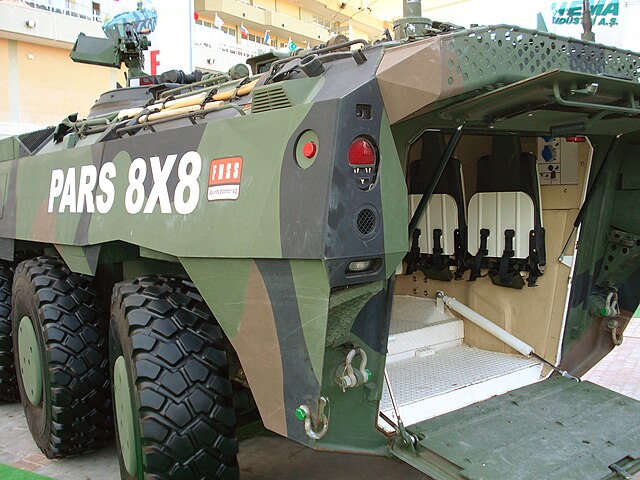Loading AI tools
Turkish armoured combat vehicle From Wikipedia, the free encyclopedia
The Pars (Turkish for Anatolian leopard) is an amphibious armoured combat vehicle family with 4×4, 6×6 and 8×8 versions, produced by FNSS Defence Systems of Turkey.[5][6][7]
| FNSS Pars | |
|---|---|
| Type | Armoured combat vehicle |
| Place of origin | Turkey |
| Service history | |
| In service | 2005 – Present[1] |
| Used by | See Operators |
| Production history | |
| Designer | FNSS Defence Systems |
| Manufacturer | FNSS Defence Systems |
| Produced | 2005 – present |
| No. built | 172 (6x6) & (8x8) ordered by Oman[1] |
| Variants | Armored personnel carrier, Infantry fighting vehicle |
| Specifications | |
| Mass | 16,130-24,500 kg |
| Length | 5 m (FNSS Pars 4x4), 6.6 m (FNSS Pars 6×6), 8 m (FNSS Pars8×8),[1] 8,11 m (GPV Colonel),[2] 9,26 m (GPV General) [3] |
| Width | 2.7 m[1] |
| Height | 2.17 m[1] |
| Crew | 5 (FNSS Pars 4x4), 10 (FNSS Pars 6×6), 14 (FNSS Pars 8×8),[1] 14 (GPV Colonel),[2] 18 (GPV General) [3] |
| Armor | Baseline 7.62mm AP all-around up to STANAG 4569 Level 4[1] |
Main armament | 25 mm FNSS Sharpshooter Turret[1] |
Secondary armament | 7.62 mm coaxial machine gun[1] |
| Engine | Deutz or Caterpillar Diesel[1] 500-600 hp (6×6 and 8×8)[1] |
| Power/weight | 20.4 to 24.5 hp/ton[1] |
| Suspension | semi-automatic computer-controlled pneumatic suspension[1] |
Operational range | 1,000 km (620 mi)[1] |
| Maximum speed | 100 km/h (62 mph) on land,[1] 8 km/h (4.97 mph) on water[4] |

The development of the PARS vehicles commenced in 2002, based on a design by US company GPV (General Purpose Vehicles), and in cooperation with GPV.[8][unreliable source?][9] PARS 4×4 and PARS 6×6 is being proposed for the Turkish Army. PARS 8×8 was first displayed in February 2005 during the IDEX defence equipment exhibition held in Abu Dhabi. GPV offered 2 more technically different vehicles, the 8×8 GPV Colonel and the 10×10 GPV General.[10][8][3] Since the first PARS vehicles were shown in 2005 development and further enhancements have been carried out on a continuous basis.[11][unreliable source?]
It was demonstrated in the deserts of the UAE in 2008 covering 11,000 km of desert and road trials. Further testing was again carried out in the UAE deserts in 2010. The PARS 8x8, fitted with a 25mm gun turret, was also successfully tested by another Middle Eastern country in the summer of 2010.[11]
On March 29, 2022, FNSS and Deftech proposed the PARS III 6×6 for Malaysian military service.[12]

The baseline PARS has a hull consisting of a steel armour.[11]
The driver and commander are seated in a cockpit at the front of the vehicle. Each has a single-piece roof hatch that opens to the side. Both have access to flat-panel displays, on which all relevant information is shown. The seating arrangement depends on the role but the troops are normally seated on individual seats down each side of the hull facing inwards. These shock-absorbing seats are fitted with five-point seatbelts as standard. A large ramp fitted at the rear section will be used for entry and exit of troops.[citation needed]

The modular design of the PARS will incorporate external turrets or weapon stations depending on user requirements. It could be a one or two-man turret or a remotely operated weapon station. To allow for PARS to be rapidly reconfigured for different operational roles, all members of the PARS family have removable roofing so that they can be quickly converted for a wide range of specialist roles.[11]
The PARS 8×8 vehicle was examined by the Malaysian Army competing with the Swiss Mowag Piranha and the Finnish Patria AMV for the implementation of technology to the first Malaysian indigenous armoured vehicle. AV8 Gempita was the result of Malaysian-Turkey collaboration in Malaysia's first indigenous armoured vehicle project with the implementation of PARS technology to its new army armoured vehicle.[citation needed]
Seamless Wikipedia browsing. On steroids.
Every time you click a link to Wikipedia, Wiktionary or Wikiquote in your browser's search results, it will show the modern Wikiwand interface.
Wikiwand extension is a five stars, simple, with minimum permission required to keep your browsing private, safe and transparent.